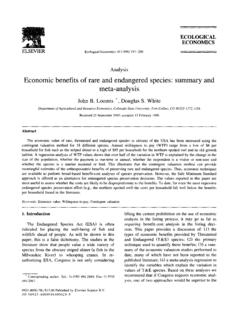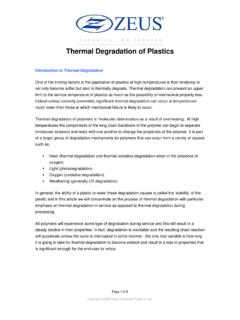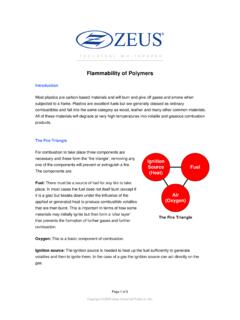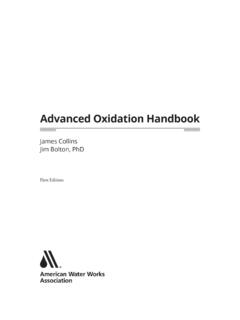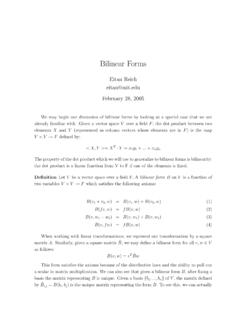Transcription of TECHNICAL WHITEPAPER Thermal Degradation of Plastics
1 TECHNICAL WHITEPAPER Thermal Degradation of Plastics Introduction to Thermal Degradation One of the limiting factors in the application of Plastics at high temperatures is their tendency to not only become softer but also to thermally degrade. Thermal Degradation can present an upper limit to the service temperature of Plastics as much as the possibility of mechanical property loss. Indeed unless correctly prevented, significant Thermal Degradation can occur at temperatures much lower than those at which mechanical failure is likely to occur. Thermal Degradation of polymers is molecular deterioration as a result of overheating . At high temperatures the components of the long chain backbone of the polymer can begin to separate (molecular scission) and react with one another to change the properties of the polymer.
2 It is part of a larger group of Degradation mechanisms for polymers that can occur from a variety of causes such as: Heat ( Thermal Degradation and Thermal oxidative Degradation when in the presence of oxygen). Light (photodegradation). Oxygen (oxidative Degradation ). Weathering (generally UV Degradation ). In general, the ability of a plastic to resist these Degradation causes is called the stability of the plastic and in this article we will concentrate on the process of Thermal Degradation with particular emphasis on Thermal Degradation in service as opposed to Thermal Degradation during processing. All polymers will experience some type of Degradation during service and this will result in a steady decline in their properties. In fact, Degradation is inevitable and the resulting chain reaction will accelerate unless the cycle is interrupted in some manner - the only real variable is how long it is going to take for Thermal Degradation to become evident and result in a loss in properties that is significant enough for the end-user to notice.
3 Page 1 of 8 Copyright 2005 Zeus Industrial Products, Inc. Page 2 of 8 Copyright 2005 Zeus Industrial Products, Inc. The Results of Thermal Degradation The chemical reactions involved in Thermal Degradation lead to physical and optical property changes relative to the initially specified properties. Thermal Degradation generally involves changes to the molecular weight (and molecular weight distribution) of the polymer and typical property changes include: Reduced ductility and embrittlement Chalking Color changes Cracking General reduction in most other desirable physical properties The dominant mechanism of Degradation and the degree of resistance to Degradation depends on the application and the polymer concerned. The results are the same for most polymer families and significant property Degradation can occur when Thermal Degradation does occur.
4 Polypropylene is very susceptible to Thermal Degradation , even at normal temperatures and must always be protected against Thermal Degradation . Thermal Degradation causes chain scission and the reduced chain length reduces the molecular weight. This can considerably change the mechanical properties leading to highly reduced ductility and embrittlement and possible service failure. Polyethylenes are also susceptible to Thermal Degradation and the resulting chain branching and cross-linking reduces the melt flow and produces embrittlement and color changes. PVC is also very susceptible to Thermal Degradation , particularly during processing, and can suffer from extensive property loss if not adequately protected against Thermal Degradation during processing. Heat stabilizers are a vital part of any PVC blend In general, the fluoropolymers processed by Zeus (such as PTFE, FEP, PFA, PVDF, THV, ETFE and ECTFE) have excellent intrinsic Thermal Degradation properties because of the strength of the carbon - fluorine (C-F) bonds in the long chain backbone.
5 As a general rule the fluoropolymers do not require the use of additional stabilizers to protect them against Thermal Degradation . These polymers are amongst the best available for resistance to long-term Thermal Degradation as well as having excellent high temperature mechanical performance properties. Other polymers processed by Zeus (such as PEEK and Ultem ) also have excellent resistance to Thermal Degradation because of the strong bonds in their long chain backbone that restrict movement . These polymers also perform exceptionally well in long-term Thermal Degradation testing. Page 3 of 8 Copyright 2005 Zeus Industrial Products, Inc. The Mechanism of Thermal Degradation Most types of Degradation follow a similar basic pattern. The conventional model for Thermal Degradation is that of an autoxidation process which involves the major steps of initiation, propagation, branching, and termination.
6 Initiation The initiation of Thermal Degradation involves the loss of a hydrogen atom from the polymer chain (shown below as ) as a result of energy input from heat or light. This creates a highly reactive and unstable polymer free radical (R*) and a hydrogen atom with an unpaired electron (H*). The strength of the C-F bond means that there it is much harder for Thermal Degradation to initiate. Propagation The propagation of Thermal Degradation can involve a variety of reactions and one of these is where the free radical (R*) reacts with an oxygen (O2) molecule to form a peroxy radical (ROO*) which can then remove a hydrogen atom from another polymer chain to form a hydroperoxide (ROOH) and so regenerate the free radical (R*). The hydroperoxide can then split into two new free radicals, (RO*) + (*OH), which will continue to propagate the reaction to other polymer molecules.
7 The process can therefore accelerate depending on how easy it is to remove the hydrogen from the polymer chain. Termination The termination of Thermal Degradation is achieved by mopping up the free radicals to create inert products. This can occur naturally by combining free radicals or it can be assisted by using stabilizers in the plastic. A general mechanism for Thermal Degradation is shown below: Page 4 of 8 Copyright 2005 Zeus Industrial Products, Inc. InitiationPropagationTerminationR . HR* + H*R* + O2R . O . O*R . O . OH + R*R . O . O* + R . HR* + R*R* + R . O . O*R . O . O* + R . O . O*Inert productsHeat and/or lightX* = Free radicalR . O . O* + OH*R . O . OH In some polymers it is also possible to get branching of the polymer chains, this is where two polymer chains become linked together and results in cross-linking and embrittlement of the polymer.
8 Protecting Plastics with Stabilizers Plastics can be protected from Thermal Degradation by incorporating stabilizers into them. Stabilizers are used to keep the polymer chains and the original molecular structure intact and therefore properties such as strength, stiffness and toughness can be retained over a longer period. Stabilizers can work in a variety of ways but in most cases they work by interrupting the Thermal Degradation cycle to slow down or prevent the cycle from completing. Some stabilizers work by mopping up the available free radicals ( radical scavengers). In this case the stabilizer reacts rapidly with the available free radicals to produce another much less active free radical and thus slow the process down. Page 5 of 8 Copyright 2005 Zeus Industrial Products, Inc.
9 Protecting Plastics with radical scavenger stabilizers A second group of stabilizers work by reacting with the hydroperoxide (ROOH) to produce inactive and stable products such as ROH and break the cycle at the hydroperoxide propagation step. Other groups of stabilizers exist for specific materials and applications and there are many different chemical families of stabilizers. In most cases a given plastic will incorporate a mix of stabilizers that are designed to work as a system to give the desired properties for the application. This mix will be designed specifically for the polymer being used and the requirements of the application. The mixture will also be designed to be applied at a specific concentration over dosing stabilizers can in fact be detrimental to the plastic and the effect of the stabilizer.
10 The expert advice of the stabilizer manufacturer needs to be sought to get the best protection and balance of effectiveness and cost. Testing Plastics for Thermal Stability and Predicting Lifetimes Testing of Plastics for Thermal stability is subject to the same concerns as any accelerated test method. In general, accelerated testing involves high temperatures over short times and the results are then extrapolated back to the lower service temperature and longer time of the real application. In this situation there is always a need to balance the time taken for the test against the error that is naturally involved in extrapolating back to the service temperature. Page 6 of 8 Copyright 2005 Zeus Industrial Products, Inc. The assumed mechanism is generally an Arrhenius model (first proposed by the Swedish chemist Svante Arrhenius) and a typical plot is shown below: 1/Temperature (K)Ln resultExtrapolated predictionExtrapolating actual results to predict results at lowertemperaturesPredicting a lifetime using this type of plot assumes that the mechanism is a standard thermally controlled one and that there is only one type of mechanism involved in the Degradation .

